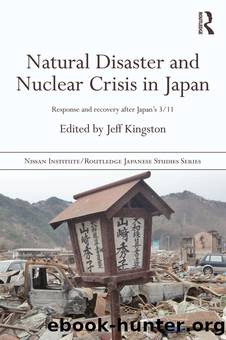Natural Disaster and Nuclear Crisis in Japan: Response and Recovery After Japan's 311 by Jeff Kingston

Author:Jeff Kingston [Kingston, Jeff]
Language: eng
Format: epub
Tags: Political Science, General, Social Science, Ethnic Studies, Regional Studies
ISBN: 9781136343476
Google: JtXFBQAAQBAJ
Goodreads: 14835861
Publisher: Routledge
Published: 2012-03-12T11:24:54+00:00
Feasibility and Performance: Whither Japan?
Speaking at an energy symposium in Chino, Nagano prefecture, on 31 July 2011, Prime Minister Kan argued that Japan âcannot take a risk [with nuclear power] that could destroy the Earth even if it is a one in a hundred million chance⦠Renewable energy will lead to Japanâs new industrial revolutionâ (Kyodo 2011). Such rhetoric aside, one of the most important questions to analyze is the feasibility of the national energy policy in a post-Fukushima Japan. Notwithstanding the technological constraints and innovations of new renewables versus nuclear power, one should consider underlying supply and demand for electric power in cross-national context â two sides of the same political and economic coin.
In fiscal year 2010 (ending March 2011), almost 1,112 terawatt-hours of electricity were generated in Japan, a 4 percent increase from 2000. The Japan Center for Economic Research forecasts 1.1 percent growth in GDP in 2000â 2025 for its positive case. If GDP growth leads to increased consumption of electricity in Japan as econometric studies have suggested (Cheng 1998; Lee 2006), new renewables would need to increase by seven to eight times to achieve the 20 percent generation target and the 70 percent targets for energy independence ratio and zero-emission generation sources, respectively. Yet, this increase of seven or eight times assumes no growth in conventional fossil-fuel generated sources or nuclear power. Moreover, should Japanâs 54 nuclear power plants gradually be decommissioned without further nuclear build â as Kan and others have suggested should happen â these targets will be extremely difficult to reach.
About 18.8 gigawatts (GW) of generating capacity are currently under construction with most being gas-fired and coal-fired power plants. A further 30.8 GW is planned, including 42 megawatts (0.1 percent) of new renewables, by 2015. If Japan hopes to achieve its GHG emission target reductions, it will depend greatly on the amount of renewable energy and nuclear power it can commercially introduce over the next 20 years. As of August 2011, these prospects appear dim; only 19 of Japanâs 54 nuclear reactors (35 percent) are on-line with political pressure to maintain the status quo until safety assurances are met (JAIF 2011a).
Virtually all OECD countries provide ânew renewableâ generation at some level. However, geography, market structure, and government policy determine the quantity. Denmark (wind), Germany (solar), Iceland (geothermal), and Spain (wind/solar) provide 15~30 percent of their total generated electricity from new renewables. In contrast with Japan, however, all four leading countries in renewable energy had relatively low electricity prices in 1990 before the introduction of feed-in tariffs. In addition, electricity capacity reserve margins â a common metric for surplus capacity â indicated percentages well above 20 percent (Table 8.2). This pre-existing oversupply prevented the intermittent supplies generated by new renewables from risking blackouts as surplus back-up power existed in the event that solar, wind, and other renewables were unable to meet peak demand.
Table 8.2 International comparison, 1990 vs. 2010
Download
This site does not store any files on its server. We only index and link to content provided by other sites. Please contact the content providers to delete copyright contents if any and email us, we'll remove relevant links or contents immediately.
The European Opportunity by Felipe Fernández-Armesto(562)
The European History Highway: A Guide to Internet Resources by Dennis A. Trinkle Scott A. Merriman(514)
The Seven Wonders of the Ancient World by Michael Denis Higgins(505)
European Security in a Global Context by Thierry Tardy(494)
European Security without the Soviet Union by Stuart Croft Phil Williams(489)
The Routledge companion to Christian ethics by D. Stephen Long Rebekah L. Miles(485)
Morgan Kaufmann Digital Watermarking and Steganography by Ingemar Cox Matthew Miller Jeffrey Bloom Jessica Fridrich Ton(464)
Hyperculture by Byung-Chul Han(457)
Get Real with Storytime by Julie Dietzel-Glair & Marianne Crandall Follis(423)
Hudud Al-'Alam 'The Regions of the World' - a Persian Geography 372 A.H. (982 AD) by V. V. Minorsky & C. E. Bosworth(421)
Gorbachev And His Generals by William C. Green(410)
Tibetan Studies in Comparative Perspective by Chih-yu Shih Yu-Wen Chen(406)
Governance, Growth and Global Leadership by Espen Moe(402)
CliffsNotes on Fitzgerald's The Great Gatsby by Kate Maurer(382)
How Languages Are Learned 5th Edition by Patsy M Lightbown;Nina Spada; & Nina Spada(378)
The Oxford History of the World by Fernández-Armesto Felipe;(374)
The Egyptian Economy, 1952-2000 by Khalid Ikram(370)
Oral Poetry and Narratives from Central Arabia: The Poetry of Ad-Dindan : A Bedouin Bard in Southern Najd (Studies in Arabic Literature, Vol 17) (English and Arabic Edition) by P. M. Kupershoek P. Marcel Kurpershoek(357)
The Oxford Handbook of the Incas by Sonia Alconini(351)
